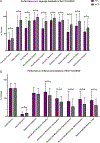Measurement and characterization of distinctive clinical phenotypes using the Frontotemporal Lobar Degeneration Module (FTLD-MOD)
- PMID: 32400973
- PMCID: PMC7580870
- DOI: 10.1002/alz.12098
Measurement and characterization of distinctive clinical phenotypes using the Frontotemporal Lobar Degeneration Module (FTLD-MOD)
Abstract
Introduction: The Frontotemporal Lobar Degeneration Module (FTLD-MOD) was designed as a research neuropsychological battery to evaluate clinical symptoms associated with FTLD. This study investigated whether the FTLD-MOD could differentiate between primary progressive aphasia (PPA) and behavioral variant frontotemporal dementia (bvFTD), two distinct FTLD-related syndromes.
Methods: Retrospective analysis was conducted on data collected from the initial visit of 165 subjects with PPA, 268 with bvFTD, and 251 cognitively normal controls from the National Alzheimer's Coordinating Center. Generalized linear models were used to compare group performance patterns on FTLD-MOD tasks of language, behavior, and memory.
Results: PPA participants showed significantly poorer performances on all language tasks whereas bvFTD participants demonstrated poorer performances on most behavioral measures. There were no differences in memory performances. Descriptive data on participant groups are provided for reference.
Discussion: Findings from this multi-center sample suggest that the FTLD-MOD can differentiate between distinctive clinical phenotypes commonly associated with FTLD.
Keywords: FTLD-MOD; behavioral variant frontotemporal dementia; frontotemporal lobar degeneration; primary progressive aphasia.
© 2020 The Authors. Alzheimer's & Dementia published by Wiley Periodicals, Inc. on behalf of Alzheimer's Association.
Conflict of interest statement
CONFLICTS OF INTEREST
The authors have no competing interests to declare.
Figures

References
-
- The Association for Frontotemporal Degeneration. Disease Overview. Available at: https://www.theaftd.org/what-is-ftd/disease-overview/ Published 2019. Accessed.
-
- Neary D, Snowden JS, Gustafson L, et al. Frontotemporal lobar degeneration: a consensus on clinical diagnostic criteria. Neurology. 1998;51(6):1546–1554. - PubMed
-
- Mesulam MM. Primary progressive aphasia–a language-based dementia. N Engl J Med. 2003;349(16):1535–1542. - PubMed
-
- Hodges JR, Davies RR, Xuereb JH, et al. Clinicopathological correlates in frontotemporal dementia. Ann Neurol. 2004;56(3):399–406. - PubMed
-
- Beekly DL, Ramos EM, Lee WW, et al. The National Alzheimer’s Coordinating Center (NACC) database: the uniform data set. Alzheimer Dis Assoc Disord. 2007;21(3):249. - PubMed
Publication types
MeSH terms
Grants and funding
- P50 AG005142/AG/NIA NIH HHS/United States
- P30 AG066515/AG/NIA NIH HHS/United States
- P30 AG066519/AG/NIA NIH HHS/United States
- P50 AG016573/AG/NIA NIH HHS/United States
- P50 AG047266/AG/NIA NIH HHS/United States
- P50 AG025688/AG/NIA NIH HHS/United States
- P50 AG005138/AG/NIA NIH HHS/United States
- P50 AG047366/AG/NIA NIH HHS/United States
- P30 AG019610/AG/NIA NIH HHS/United States
- P50 AG033514/AG/NIA NIH HHS/United States
- P30 AG013854/AG/NIA NIH HHS/United States
- P30 AG053760/AG/NIA NIH HHS/United States
- P30 AG066444/AG/NIA NIH HHS/United States
- P30 AG010124/AG/NIA NIH HHS/United States
- P50 AG023501/AG/NIA NIH HHS/United States
- P50 AG005131/AG/NIA NIH HHS/United States
- P30 AG010133/AG/NIA NIH HHS/United States
- P50 AG016574/AG/NIA NIH HHS/United States
- P30 AG066511/AG/NIA NIH HHS/United States
- P50 AG005146/AG/NIA NIH HHS/United States
- U24 AG072122/AG/NIA NIH HHS/United States
- P30 AG035982/AG/NIA NIH HHS/United States
- P50 AG008702/AG/NIA NIH HHS/United States
- U01 AG016976/AG/NIA NIH HHS/United States
- P30 AG008051/AG/NIA NIH HHS/United States
- P50 AG005681/AG/NIA NIH HHS/United States
- P30 AG013846/AG/NIA NIH HHS/United States
- P50 AG047270/AG/NIA NIH HHS/United States
- P30 AG062429/AG/NIA NIH HHS/United States
- P50 AG005136/AG/NIA NIH HHS/United States
- P30 AG072973/AG/NIA NIH HHS/United States
- P30 AG049638/AG/NIA NIH HHS/United States
- P30 AG012300/AG/NIA NIH HHS/United States
- P50 AG005134/AG/NIA NIH HHS/United States
- P30 AG008017/AG/NIA NIH HHS/United States
- P30 AG010161/AG/NIA NIH HHS/United States
- P30 AG066530/AG/NIA NIH HHS/United States
- P50 AG005133/AG/NIA NIH HHS/United States
- P30 AG066509/AG/NIA NIH HHS/United States
- P30 AG066468/AG/NIA NIH HHS/United States
- P30 AG010129/AG/NIA NIH HHS/United States
- P30 AG066506/AG/NIA NIH HHS/United States
- R01 AG062566/AG/NIA NIH HHS/United States
- P30 AG066514/AG/NIA NIH HHS/United States
- P30 AG028383/AG/NIA NIH HHS/United States
LinkOut - more resources
Full Text Sources
Medical

